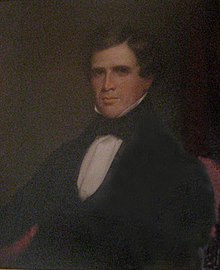Charles Paine | |
|---|---|
 Official Vermont State House portrait | |
| 15th Governor of Vermont | |
| In office October 15, 1841 – October 13, 1843 | |
| Lieutenant | Waitstill R. Ranney |
| Preceded by | Silas H. Jennison |
| Succeeded by | John Mattocks |
| Member of the Vermont House of Representatives | |
| In office 1828–1830 | |
| Preceded by | John Starkweather |
| Succeeded by | Lebbeus Bennett |
| Personal details | |
| Born | April 15, 1799 Williamstown, Vermont |
| Died | July 6, 1853 (aged 54) Waco, Texas |
| Resting place | Elmwood Cemetery, Northfield, Vermont |
| Political party | Whig |
| Domestic partner | Lorinda Stevens |
| Children | 2 |
| Alma mater | Harvard College |
| Profession | Businessman |
Charles Paine (April 15, 1799 – July 6, 1853) was an American Whig politician, woolen mill owner, merchant, railroad builder, and the 15th governor of Vermont.
Biography[edit]
Paine was the son of Elijah Paine and Sarah (Porter) Paine, and was born in Williamstown, Vermont. He graduated from Harvard University in 1820,[1][2] and became active in several business ventures. Though he never married, he had two children with Lorinda Stevens of Northfield.[3][4]
Career[edit]
Paine moved to Northfield, Vermont in the early part of the nineteenth century to run the family woolen mill. He operated this business until it was destroyed by fire in 1848. Paine's Meeting House was built in 1835 for the mill's workers as a place for worship. It still functions as one today. He had various other business interests including a hotel and a store, but he is most often remembered as the individual who brought railroads to Vermont. He founded the Vermont Central Railroad and served as the first president of the company.[5]
In Northfield, Paine held the offices of Town Selectman and Moderator of the Town Meeting. In his political life he was a member of the Vermont House of Representatives from 1828 through 1829. He was the 15th Governor of Vermont from 1841 until 1843. During his tenure, a stricter accounting of public funds was established.[6]
As the founder and president of the Vermont Central Railroad Paine built its headquarters in his home town of Northfield, despite the hilly terrain, earning the enmity of residents of larger, more accessible nearby towns. In the extensive yard, engines and railroad cars were built and repaired.[7] In 1853 the Vermont Central Railroad went into bankruptcy due to overexpansion and, in some cases, mismanagement. The railroad was placed under receivership and renamed the Central Vermont Railroad. Its headquarters were moved to St. Albans.
Death[edit]
Paine died in Waco, Texas after three weeks of dysentery while helping the Southern Pacific Railroad choose a route. He is interred at Elmwood Cemetery, Northfield, Washington County, Vermont.[8] Paine's home at 75 South Main Street, in Northfield is the location of the Northfield Historical Society, and is connected by an extension to the town's Brown Public Library.[9]
References[edit]
- ^ Porcellian Club of Harvard University (1857). Catalogue of the Porcellian Club of Harvard University. Cambridge, MA: Allen and Farnham. p. 32.
- ^ Harvard University (1900). Quinquennial Catalogue of the Officers and Graduates of Harvard University. Cambridge, MA: John Wilson and Son. p. 144.
- ^ "Charles Paine". National Governors Association. Retrieved October 31, 2012.
- ^ Bassett, Thomas Day Seymour (1992). The Growing Edge: Vermont Villages, 1840-1880. Montpelier, VT: Vermont Historical Society. p. 100. ISBN 978-0-9347-2036-6 – via Google Books.
- ^ "Charles Paine". National Governors Association. Retrieved October 31, 2012.
- ^ "Charles Paine". National Governors Association. Retrieved October 31, 2012.
- ^ "Charles Paine". Central Vermont Chamber of Commerce. Archived from the original on June 26, 2006. Retrieved October 31, 2012.
- ^ "Charles Paine". The Political Graveyard. Archived from the original on November 2, 2012. Retrieved October 31, 2012.
- ^ "Charles Paine". Northfield Historical Society. Archived from the original on November 7, 2012. Retrieved October 31, 2012.
Further reading[edit]
- New England Puritan (published in Boston), Thursday, August 4, 1853
External links[edit]
- The Political Graveyard
- Central Vermont Chamber of Commerce
- National Governors Association
- Charles Paine at Find a Grave
- Northfield Historical Society
